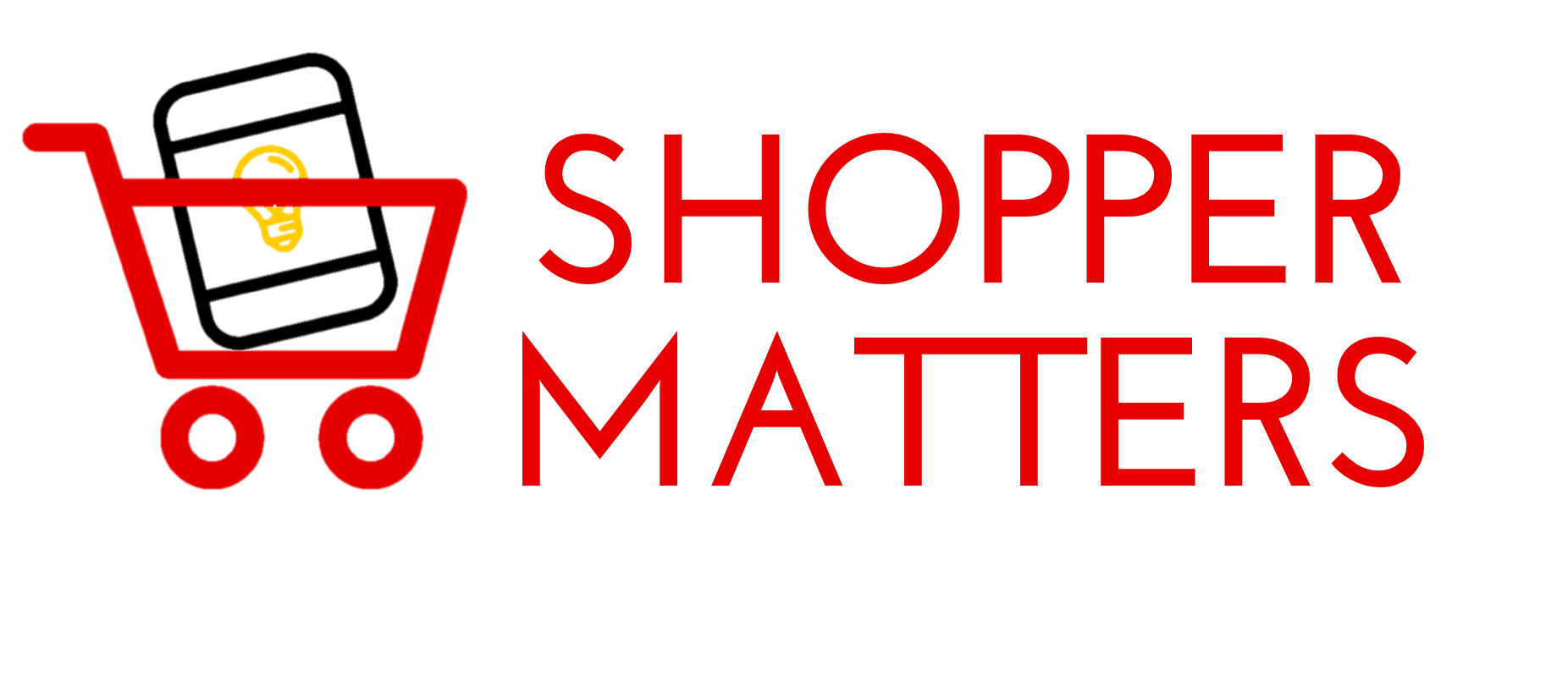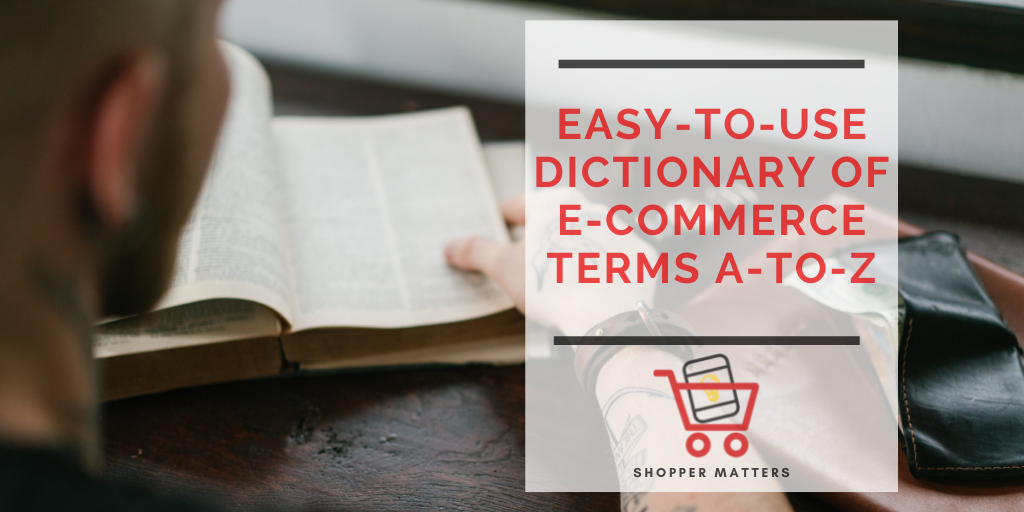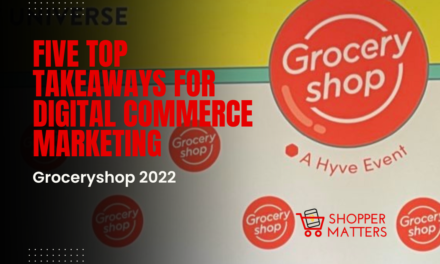E-COMMERCE IS HARD, BUT IT DOESN’T NEED TO BE
E-commerce is complicated. Sometimes you just need a refresher on a key concept or idea. Sometimes the buzz words can be too much and you need a resource for a quick answer. Have we got a treat for you. See below for your easy to use Dictionary of E-Commerce Terms, A to Z.
Average Order Value (AOV)
Definition: Average Order Value (AOV) is an e-commerce metric that measures the average total of every order placed with a merchant over a defined period. AOV is one of the most important metrics for online stores to be aware of, driving key business decisions such as advertising spend, store layout, and product pricing. Average Order Value is a benchmark of customer purchasing behavior. The formula for calculating AOV is revenue divided by number of orders.
Why it Matters: Understanding your company’s average order value helps you evaluate your pricing strategy and online marketing efforts by providing the metrics needed to measure the long-term value of individual customers. AOVs aid goal setting and strategy enhancement and help you to evaluate how well those business strategies are working. An increase in AOVs for online retailers strongly correlates to an increase in profit. When a retailer or brand improves their average order value, they can directly improve profit and revenue growth.
CASH CONVERSION CYCLE (CCC)
Definition: The Cash Conversion Cycle expresses the time (measured in days) it takes for a company to convert its investments in inventory and other resources into cash flows from sales. Also called the Net Operating Cycle or simply Cash Cycle, CCC attempts to measure how long each net input dollar is tied up in the production and sales process before it gets converted into cash received.
Why it Matters: Cash Conversion Cycle is an essential metric for a business to determine the efficiency of converting its inventory into sales and then into cash. A company that can push cash through its operating cycle faster can reinvest that cash more often. If your business has a shorter CCC than your competitors, you can grow the company faster without having to rely on capital markets.
CLICK TO OPEN RATE (CTR)
Definition: The Click-to-Open Rate compares the number of unique clicks to unique opens of an email. This number indicates how effective the email message, design, and content performed and whether it created enough interest in the recipient to take action.
Why it Matters: Unlike the Click-Through Rate, the Click-to-Open Rate is the number of clicks out of the number of opens (instead of the number of delivered emails). CTR offers a better gauge of how the email design and messaging resonated with your audience since these clicks are only from people that viewed your email.
CONTENT MANAGEMENT SYSTEM (CMS)
Definition: A Content Management System (CMS) is a software application that enables users to create, edit, collaborate on, publish and store digital content. CMSes are typically used for enterprise content management (ECM) and web content management (WCM).
Why it Matters: Having a Content Management System for your website allows you to have better control of your content. It provides the ability to easily update, change or delete any images, text, video, or audio. It allows you to keep your site organized and looking great.
CONTRIBUTION MARGIN
Definition: Contribution Margin, or dollar contribution per unit, is the selling price per unit minus the variable cost per unit. “Contribution” represents the portion of sales revenue not consumed by variable costs and contributes to the coverage of fixed costs.
Why it Matters: Analyzing the contribution margin helps managers make several types of decisions, from adding or subtracting a product line to how to price a product or service to structure sales commissions. The most common use is comparing products and determining which to keep and which to eliminate. If a product’s contribution margin is negative, the company is losing money with each unit it produces, and it should either drop the product or increase prices. If a product has a positive contribution margin, it’s usually worth keeping.
CONVERSION RATE
Definition: Conversion Rate records the percentage of users who have completed the desired action. Calculate the Conversion Rates by taking the total number of users who ‘convert’ (for example, by clicking on an advertisement), dividing it by the overall size of the audience, and converting that figure into a percentage.
Why it Matters: Conversion Rates are an effective way to compare and contrast the performance of multiple advertising channels. Conversion Rates are vital when running mobile user acquisition because they can measure the success of each campaign; they can also be used to set ROI expectations when scaling a campaign.
CONVERSION RATE OPTIMIZATION
Definition: Conversion Rate Optimization (CRO) is the practice of increasing the percentage of users who perform a desired action on a website. Desired actions can include purchasing a product, clicking ‘add to cart’, signing up for a service, filling out a form, or clicking on a link.
Why it Matters: Conversion Rate Optimization is important because it allows you to lower your customer acquisition costs by getting more value from the visitors and users you already have. By optimizing your conversion rate, you can increase revenue per visitor, acquire more customers, and grow your business.
COST PER ACQUISITION (CPA)
Definition: Cost Per Acquisition, or “CPA,” is a vital measurement of marketing success; it measures the aggregate cost to acquire one paying customer on a campaign or channel level.
Why it Matters: Many marketing metrics are indicators of success, such as Conversion Rate and Visits (or “sessions”). On the other hand, Cost Per Acquisition is a financial metric used to directly measure the revenue impact of marketing campaigns. Conversion Rate is a primary indicator of marketing success, but CPA provides the business perspective by which to gauge campaign success.
COST PER CLICK (CPC)
Definition: Cost Per Click (CPC) refers to the actual price you pay for each click in your pay-per-click (PPC) marketing campaigns. Average Cost Per Click (avg. CPC) is calculated by dividing the total cost of your clicks by the total number of clicks. CPC is also the online advertising revenue model that websites use to bill advertisers based on the number of times visitors click on a display ad attached to their sites. The cost-per-click model is also known as pay-per-click (PPC).
Why it Matters: Cost Per Click is commonly used by advertisers who have a set daily budget for a campaign. When the advertiser’s budget is reached, the ad is automatically removed from the website’s rotation for the remainder of the billing period. The more users directed to your website, the more opportunities you have to convert their interest into sales. Coupled with that, the less you pay per click, the higher your ROI.
COST PER LEAD (CPL)
Definition: Cost Per Lead, often abbreviated as CPL, is an online advertising pricing model where advertisers pay for an explicit sign-up from a person interested in the offer. It is also commonly called online lead generation. The formula for CPL is simple; just take the total marketing spend and divide it by the total number of new leads.
Why it Matters: The Cost Per Lead metric enables sales and marketing teams to set their sales goals, calculate potential ROI, and determine advertising budgets. Continuously tracking CPL and Conversion Rate enables companies to make strategic decisions on where to target marketing efforts.
COST PER ORDER (CPO)
Definition: Cost Per Order (CPO) is the total marketing spend needed to drive any purchase to your store. Therefore, it includes both new and returning customers. To calculate CPO, divide your brand’s variable marketing cost by the number of orders.Cost Per Order is sometimes confused with Cost Per Acquisition, which only calculates the cost to acquire only new customers. CPO is also commonly used as a pricing model for internet advertising. It means that an advertiser only pays a fee when an actual purchase occurs (often applied in affiliate marketing).
Why it Matters: Successful e-commerce brands understand their historical spending, track their current spending, and forecast future spending. In the context of Cost Per Order, this means looking at past and present data, and a rarely-covered topic: setting spending targets on cost per order. To ensure CPO doesn’t erode profits on each sale, it’s crucial to have a thorough and accurate understanding of marketing and non-marketing costs.
COST PER THOUSAND (CPM) IMPRESSIONS
Definition: Cost Per Thousand (CPM) is a marketing term that refers to an advertiser’s cost per one thousand advertisement impressions on a web page. CPM is one of several methods used to price online ads; other methods include cost per click (CPC) and cost per acquisition (CPA).
Why it Matters: Cost Per Thousand (CPM) is the most common method for pricing ads in digital marketing. The method relies on impressions, a metric that counts the number of digital views or engagements for a particular advertisement. Impressions are also known as “ad views.” Advertisers pay website owners a set fee for every thousand impressions of an ad. Using a common metric to understand adverting reach helps marketers understand costs across potential advertising partners.
CUSTOMER ACQUISITION COST (CAC)
Definition: Customer Acquisition Cost (CAC) is a metric that has been growing with the emergence of Internet companies and web-based advertising campaigns that can be tracked. CAC is the cost of winning a customer to purchase a product/service. As an important unit economic, customer acquisition costs are often related to customer lifetime value (CLV or LTV). With CAC, any company can gauge how much they’re spending on acquiring each customer.
Why it Matters: With CAC, any company can gauge how much they’re spending on acquiring each customer. It shows the money spent on marketing, salaries, and other things to acquire a customer. This metric is critical as it helps a company calculate the resulting ROI of an acquisition. A business needs to know each customer’s starting value to know how much of its resources it should spend on a customer to be profitable.
CUSTOMER DATA PLATFORM (CDP)
Definition: A Customer Data Platform (CDP) is a software solution that aggregates and organizes customer data across a variety of touch points and is used by other software, systems, and marketing efforts. CDPs collect and structure real-time data into individual, centralized customer profiles. According to the CDP Institute, a CDP is a packaged software that creates a persistent, unified customer database that is accessible to other systems.
Why it Matters: A CDP unifies customer data around a foundational identity, while understanding who owns the customer relationship. CDP solutions process high volumes of customer data in real time and make it available to other applications, especially for data activation and marketing while ensuring enterprise data privacy and governance.
CUSTOMER LIFETIME VALUE (CLV)
Definition: Customer Lifetime Value is the total worth of a customer’s business over the whole period of their relationship. It’s an important metric as it costs less to keep existing customers than it does to acquire new ones, so increasing the value of your existing customers is a great way to drive growth.
Why it Matters: Knowing the CLV helps businesses develop strategies to acquire new customers and retain existing ones while maintaining profit margins. CLV is distinct from the Net Promoter Score (NPS), which measures customer loyalty, and CSAT which measures customer satisfaction because it is tangibly linked to revenue rather than an intangible promise of commitment and satisfaction.
CUSTOMER RELATIONSHIP MANAGEMENT SYSTEMS
Definition: Customer Relationship Management (CRM) is a technology for managing all of a company’s relationships and interactions with customers and potential customers. The goal is simple: Improve business relationships to grow your business. A CRM system helps companies stay connected to customers, streamline processes, and improve profitability. When people talk about CRM, they are usually referring to a CRM System, a tool that helps with contact management, sales management, agent productivity, and more. CRM tools can now be used to manage customer relationships across the entire customer lifecycle, spanning marketing, sales, digital commerce, and customer service interactions.
Why it Matters: A CRM solution helps companies focus on their organization’s relationships with individual people — including customers, service users, colleagues, or suppliers — throughout their lifecycle, including finding new customers, winning their business, and providing support and additional services throughout the relationship.
CUSTOMER RETENTION RATE
Definition: Customer Retention Rate measures the number of customers a company retains over a given period of time. It’s expressed as a percentage of a company’s existing customers who remain loyal within that time frame. Retention Rate is a reverse side of Churn Rate, which shows the percentage of customers a company has lost over a specific period. The importance of retention rate as a metric varies depending on the industry.
Why it Matters: Customer Retention is a key KPI, because a company’s ability to retain existing customers is fundamental to its success. Monitoring retention metrics is critical for a business to understand lifetime customer value and to quantify the efficacy of its marketing strategy and customer service program.
CUSTOMER SATISFACTION RATE (CSAT)
Definition: It’s a commonly used metric that acts as a key performance indicator for customer service and product quality in all kinds of businesses. While customer satisfaction as an idea is a general one, CSAT is a more defined metric that’s expressed as a percentage. CSAT is measured through customer feedback gathered via one or more variations of this question: “How would you rate your overall satisfaction with the [goods/service] you received?” The results can be averaged out to give a Composite Customer Satisfaction Score, although CSAT scores are more usually expressed as a percentage scale.
Why it Matters: Customer Satisfaction plays an important role within your business. Not only is it the leading indicator to measure customer loyalty, identify unhappy customers, reduce churn and increase revenue; it is also a key point of differentiation that helps you to attract new customers in competitive business environments.
Digitally Native Vertical Brand (DNVB)
Definition: A digitally native business, quite simply, is a business that began by selling its product or services online. On the other hand, a vertically integrated brand controls the product and experience of what they sell from the factory to the consumer. Therefore, a Digitally Native Vertical Brand is simply a brand that started online and controls their entire customer experience from factory to consumer. Some businesses can be digital native but not be vertically integrated, while others can be not digitally native but be vertically integrated.
Why it Matters: Because a Digitally Native Vertical Brand controls the entire customer experience, they’re able to provide much better service and support to their customers typically. By cutting out the middleman, they’re able to keep costs down for consumers. They can learn much more about their behavior when they buy, both from the information the customers provide and their actions (website engagement, how frequently they purchase, etc.). DNVBs can effectively communicate with their customers in a personalized way through owned and organic channels such as email, SMS, and social media.
DiRECT TO CONSUMER (D2C/DTC BRANDS)
Definition: Refers to selling products directly to customers, bypassing third-party retailers, wholesalers, or other middlemen. DTC brands are usually sold online only and specialize in a specific product category. This is a win-win situation for consumers and brands because it lowers costs and prices by bypassing third-party retailers.Some direct-to-consumer brands have opened a limited number of physical retail spaces in adjunct to their main e-commerce platform in a clicks-and-mortar business model.
Why it Matters: Selling direct-to-consumer ensures the quality of your product, packaging, and pricing is up to your standards. When selling directly to your end consumer, you can tell your brand’s story directly to them. Retailers and marketplaces can dilute your branding and, in some cases, subvert your brand. Your message is likely to be far less effective when alongside competing brands within reseller stores and websites. Historically, brands have sold to retailers or middlemen who maintained the relationship with their customer. Having a direct relationship keeps all the precious data about buying trends and customer data in house.
HEADLESS COMMERCE
Definition: Headless Commerce is a separation of the front end and back end of an e-commerce application. This architecture offers brands freedom of expression to build whatever and however, they want.
Why it Matters: A “Headless” content management system helps brands propel content anywhere and everywhere. For an e-commerce brand, that means delivering your products, product videos, or blog posts to any channel (existing or emerging). A headless commerce platform enables you to deploy rapid updates without impacting your back-end system. A headless commerce system can support new technology as and when they arise.
IN-STOCK RATE
Definition: Refers to the amount of an assortment that is in stock. It is calculated as: SKUs in stock divided by total available SKUs. In Stock Rate can also be measured on a door/item/SKU level for retailers. For example, if a retailer has 100 doors, and carries 10 SKUs per door, a measure of 95% in stock rate means that 950 out of 1000 door/SKU combinations have at least 1 unit in stock.
Why it Matters: In Stock Rate measures the percentage of expected demand that you have in stock and available for sale. In-stock rates are generally based on a sales forecast and are subject to forecast error. If you haven’t sold an item for a couple of months, you may have a zero forecast and won’t “ding” yourself if you are out of stock on that item. Of course, that doesn’t mean that a customer won’t buy that item. The broader and longer the “tail” of low-volume items in your catalog, the less reliable the in-stock rate will be as a metric.
INVENTORY TURNOVER RATE
Definition: Inventory Turnover Rate is a financial ratio showing how many times a company has sold and replaced inventory during a given period. A company can then divide the days in the period by the inventory turnover formula to calculate the days it takes to sell the inventory on hand.
Why it Matters: Calculating inventory turnover can help businesses make better pricing, manufacturing, marketing, and inventory pricing decisions. Inventory turnover measures how fast a company sells inventory. A low turnover implies weak sales and possibly excess inventory, also known as overstocking. It may indicate a problem with the goods offered for sale or result from too little marketing.
KEY PERFORMANCE INDICATORS (KPIs)
Definition: Key Performance Indicators are the critical (key) indicators of progress toward an intended result. KPIs provide a focus for strategic and operational improvement, create an analytical basis for decision making and help focus attention on what matters most.
Why it Matters: Key Performance Indicators are an essential part of measuring the successes and failures of your business. a KPI allows business owners and managers to get an overview of how their business is performing at any given time. KPIs measure the business against actual, quantifiable data during a specified timeframe. Companies may have multiple KPIs for each department or segment of the business.
LOW FUNNEL MARKETING
Definition: Low Funnel Marketing targets people you know are about to become buyers or clients. It’s the people who might have something in their cart but have yet to proceed to check-out i. It can also be advertising to people directly searching for the problems your brand, product, or service helps solve.
Why it Matters: The “bottom of the funnel” represents the point at which the buyer has decided they want to move ahead with a purchase. Here, they are figuring out whether they should make that purchase with your brand or with a competitor. At this stage, marketers may need to give prospects a little nudge to get them to buy.
NET PROMOTER SCORE
Definition: Net Promoter Score® (or NPS®) measures customer experience and predicts business growth. This proven metric transformed the business world and now provides the core measurement for customer experience management programs the world round. Calculate NPS using the answer to a key question, using a 0-10 scale: “How likely is it that you would recommend [brand] to a friend or colleague?” Respondents are grouped as follows:
- Promoters (score 9-10) are loyal enthusiasts who will keep buying and refer others, fueling growth.
- Passives (score 7-8) are satisfied but unenthusiastic customers who are vulnerable to competitive offerings.
- Detractors (score 0-6) are unhappy customers who can damage your brand and impede growth through negative word-of-mouth.
Subtracting the percentage of Detractors from the percentage of Promoters yields the Net Promoter Score, which can range from a low of -100 (if every customer is a Detractor) to a high of 100 (if every customer is a Promoter).
Why it Matters: Net Promoter Score indicates the quality of customer service for a business in general, and compared to the competition. It provides an overall metric to track, that can indicate improvements in a product, service, or organization. Organizations can use their Net Promoter Score to address any problems areas, improve the experience of their customers, monitor loyalty trends, and grow revenue through referrals and upsells..
OUT OF STOCK RATE (OOS)
Definition: Out of Stock (OOS) Rate is the inverse of an in-stock rate and refers to the amount of an assortment that is not in stock. It is calculated as SKUs not in stock divided by total available SKUs. The importance of calculating an OOS rate is to measure the customer shopping experience and well as to quantify lost sales..
Why it Matters: When it comes to the shopping experience, increased levels of OOS can cause customer frustration and erode brand loyalty. While some believe OOS products can signify increased desire and therefore even more robust demand, the argument has yet to be quantified. Retailers should target OOS rates below 10% to protect the shopping experience, and limit lost sales.
PRODUCT DETAIL PAGE (PDP)
Definition: A Product Detail Page (PDP) is a web page on an e-commerce site that presents the description of a specific product in view. The details displayed often include size, color, price, shipping information, reviews, and other relevant information customers may want to know before purchasing. Typically, this information is presented alongside an actual photo of the item and an “add to cart” button.
Why it Matters: The product detail page is crucial to your e-commerce strategy because it is where the fate of a potential sale lives. This page has the potential to optimize the consumer experience by presenting product details the way your target consumer wishes to view content on your site. The product detail page should be designed so that a hierarchy of information is presented intuitively. A PDP must establish a healthy balance between too much information and just the right amount of detail to sway buyers’ interest in completing a purchase. For tips on optimizing your PDP, consider using IRIS from MarketingLab.
REPEAT CUSTOMER RATE
Definition: Repeat Customer Rate is the proportion of customers who have made at least two purchases during a specific period. It is usually expressed as a percentage and is a metric commonly tracked by e-commerce businesses. It’s particularly relevant for evaluating overall customer experience and understanding how much value your customers find in your store.
Why it Matters: A repeat customer has a higher chance of converting. The more repeat customers you have, the less you’ll have to spend on conversion tactics like abandoned cart offers. Repeat customers convert more often, and they have a higher average order value than first-time buyers.
RETAIL MEDIA
Definition: A Retail Media network allows a retail brand to give their partner brands access to customers, using the retailer’s key assets: their first-party customer data and channels (including their website). With the retailer’s first-party data, brands can reach in-market buyers at the point of purchase, across formats and owned channels. A successful media network is one that can effectively monetize all addressable channels in a brand-safe, privacy-compliant environment—all the way through to the end consumer.
Why it Matters: Retail Media allows brands to advertise their products near the point of sale, making it easier for consumers to convert. Retail Media opens up digital spaces that were previously off-limit to brands. Amazon led the way by introducing sponsored ads. Now, many other online retailers are following in their footsteps.
RETURN ON ADVERTISING SPEND (ROAS)
Definition: Return On Advertising Spend, (ROAS), is a marketing metric that measures the efficacy of a digital advertising campaign. ROAS helps online businesses evaluate which methods are working and how they can improve future advertising efforts.
Why it Matters: ROAS is essential for quantitatively evaluating the performance of ad campaigns and how they contribute to an online store’s bottom line. Combined with customer lifetime value, insights from ROAS across all campaigns inform future budgets, strategy, and overall marketing direction. By keeping careful tabs on ROAS, e-commerce companies can make informed decisions on where to invest their ad dollars and how they can become more efficient.
RETURN ON INVESTMENT (ROI)
Definition: Return On Investment measures the gain or loss generated on an investment relative to the investment’s cost. It is usually expressed as a percentage and is used for personal financial decisions to compare a company’s profitability or the efficiency of different investments. The Return On Investment formula is: ROI = (Net Profit / Cost of Investment) x 100.
Why it Matters: It’s beneficial for measuring success over time and taking the guesswork out of making future business decisions. The ability to calculate return on investment is valuable for any business, regardless of size or industry. Compared to ROAS, ROI typically is a fully burdened financial calculation that goes beyond marketing.
So, what did we miss? Drop a note in the comment box. We’d be happy to add any terms you find missing and helpful to others.





